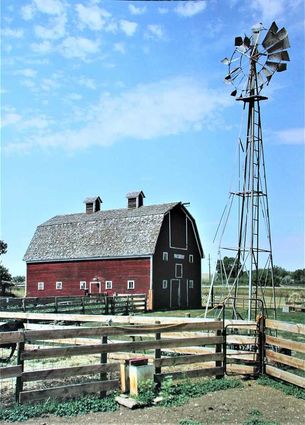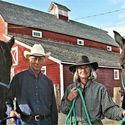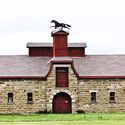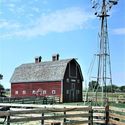Co-author of "Hand Raised: The Barns of Montana" spoke recently at Harlem Library
March 28, 2018

J.C. Adams built this stone barn near Simms, in Cascade County, that was completed in 1885. Adams grew up in Kentucky and the barn design was influenced by his familiarity with the expansive horse barns of Kentucky. The barn is not currently in use and is owned by a nonprofit that has tried several plans to assure the old barn survives. When completed the local Sun River Press called the barn the "Marvel of Montana." There are several elegant barns that still survive in Montana, built in the late 1800's by rich industrialists and people who did not make their fortunes as farmers or ranchers.
Christine Brown, Outreach and Education Director for the Montana Preservation Alliance (MPA), recently presented the third program in a series hosted by the Harlem Library and the Harlem Senior Center. Brown is the co-author of "The Barns of Montana," a 2011-released book that features pictures and stories of selected barns from different geographic regions and eras across the state. The program is part of the Montana Conversations project of Montana Humanities.
Why and how a book about barns in Montana?
The Montana Preservation Alliance (MPA) is "the only statewide, not-for-profit organization dedicated to providing Montanans with the resources necessary to preserve our state's unique history and culture." A major thrust of MPA's work is to protect historic places.
Christine Brown said the project to preserve information about Montana's barns was begun by Chere Jiusto, the Executive Director of MPA. Brown explained, "Chere and others saw that many old barns were disappearing. They began to gather information to document the barns and explain the role they played in the development of Montana." Brown added, "Once you understand something about barns and their history, you can begin to recognize the era a barn was built and why it was built in particular way."
To begin the process for selecting barns to be included in the book, researchers contacted extension agents and others involved in agriculture and ask about significant barns in their areas. All 56 counties in the state were contacted, though not all counties have barns included in the book. Once the barns for inclusion were identified, work began researching the histories of the barns and photographing them.

Brown said, "We contacted Tom Ferris, a New York City-based photographer. He had done photography in Yellowstone and we liked his work." She added that Ferris, while a great photographer, knew nothing about agriculture or livestock. "But," she said, "he adapted quickly and produced some really great shots for the book." In a two year period he drove 16,000 miles around the state to make his photographs.
It took more than ten years to complete the project. Brown explained, "We could only devote so much time to the project as we had other duties and responsibilities that had to be handled." During the period information was being gathered, some barns were lost, either to natural causes or taken down purposefully. "One of the saddest things," she added, "was that some of the people who were so helpful gathering information died during that period. They never got to see the book in its completed form."
What can be learned from a study of barns?
According to Christine Brown, taking an overall view of barns in the state, "You can see a lot about the trends in agriculture as well as changes in construction techniques. Many of the first
large scale barns were built in the late 1800's, following some very intense winter weather. Livestock owners recognized they needed more protection for their investment."
Other of the large barns, especially the very elegant ones, were a reflection of how the new rich could display their wealth. And, just like now, the occasional well off person decided to abandon the city and come "out west" to ranch or farm and succumbed to the vagaries of agricultural life. Their large barns either were abandoned or repurposed. Many large barns, particularly near populous areas, are now event centers for weddings and other gatherings.
Brown said an opposite kind of fate befell the small, "one horse barns" that were common during the frontier period. Many of those were swallowed up in to larger structures that were necessitated to house additional or new varieties of animals, protect newly acquired machinery or provide more storage. "Other frontier barns," she added, "were simple left to collapse when a new barn was built. There are very few of the old, small barns still around."
And, depending on the region of Montana, the construction of barns tells a lot about the availability of materials and labor. The availability of skilled immigrant carpenters and rock masons allowed for construction of some of the large barns with elegant features. Later, when barns had to be built by available labor, mostly family and neighbors, the construction was more utilitarian and simple.

There is only one historical barn from Blaine County listed in the 2011 "The Barns of Montana." This photos shows the Burns Barn located just south of Highway 2 at the turnoff to the town of Zurich. The barn was built by homesteader John Acher in 1910. He sold the farm to the U.S. government in 1937 during the Depression. Sam Burns bought the property from the government after World War II. The farm is still owned by a member of the Burns family.
You can learn more about barns and the work of the Montana Preservation Alliance at their website: preservemontana.org/. Every two years the MPA hosts a road show to some region of the state. Tours and information about local historic structures and culture are part of "getting out of the conference room and in to the field." This year's Road Show will be held in the Flathead/Glacier region and runs June 13-16. See the website for details.




